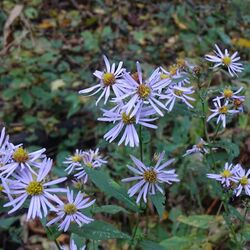Biology:Symphyotrichum prenanthoides
| Symphyotrichum prenanthoides | |
|---|---|

| |
| Scientific classification | |
| Kingdom: | Plantae |
| Clade: | Tracheophytes |
| Clade: | Angiosperms |
| Clade: | Eudicots |
| Clade: | Asterids |
| Order: | Asterales |
| Family: | Asteraceae |
| Tribe: | Astereae |
| Subtribe: | Symphyotrichinae |
| Genus: | Symphyotrichum |
| Subgenus: | Symphyotrichum subg. Symphyotrichum |
| Section: | Symphyotrichum sect. Symphyotrichum |
| Species: | S. prenanthoides
|
| Binomial name | |
| Symphyotrichum prenanthoides (Muhl. ex Willd.) G.L.Nesom[2]
| |

| |
| Native distribution[2] | |
| Synonyms[2] | |
|
Basionym
Alphabetical list
| |
Symphyotrichum prenanthoides (formerly Aster prenanthoides) is a species of flowering plant in the family Asteraceae known by the common name crookedstem aster.[3] It is native to northcentral and northeastern North America.[1]
This rhizomatous perennial herb produces colonies of plants with stems that may exceed 1 meter (3 feet 3 inches) in length. These stems grow upright to erect and may be crooked or nearly straight, often becoming thick and purple with age. The leaves vary in size and shape. The flower heads are borne in branching arrays on purplish stems. The ray florets are lavender or blue in color, or sometimes white. There are up to 30 ray florets measuring up to 15 millimeters (3⁄5 inch) in length. At the center are disk florets in shades of cream and yellow to purple or brown.[4]
This plant grows in many habitats, including woody and marshy areas as well as roadsides.[4]
Conservation
It is a special concern species in Connecticut, where it is believed to be extirpated.[5]
Uses
The Iroquois use this plant medicinally to treat fevers in babies and for other ailments.[6]
Citations
References
- Flora of North America Editorial Committee, ed. (2006), "Symphyotrichum prenanthoides", Flora of North America North of Mexico (FNA), 20, New York and Oxford, http://www.efloras.org/florataxon.aspx?flora_id=1&taxon_id=250067676, retrieved 6 July 2021
- "Connecticut's Endangered, Threatened and Special Concern Species 2015". 2015. http://www.ct.gov/deep/lib/deep/wildlife/pdf_files/nongame/ets15.pdf. "This list is newer than the one used by plants.usda.gov and is more up-to-date."
- "Symphyotrichum prenanthoides - Crooked-stem Aster". Arlington, Virginia: NatureServe. 4 June 2021. https://explorer.natureserve.org/Taxon/ELEMENT_GLOBAL.2.137173/Symphyotrichum_prenanthoides.
- "Symphyotrichum prenanthoides (Muhl. ex Willd.) G.L.Nesom". Royal Botanic Gardens, Kew. 2021. https://powo.science.kew.org/taxon/urn:lsid:ipni.org:names:981888-1.
- "Symphyotrichum prenanthoides search". n.d.. http://naeb.brit.org/uses/search/?string=Symphyotrichum+prenanthoides.
- "Symphyotrichum prenanthoides". Natural Resources Conservation Service PLANTS Database. USDA. 2014. https://plants.usda.gov/core/profile?symbol=SYPR6.
Wikidata ☰ {{{from}}} entry
 |


